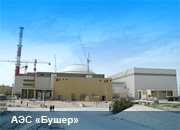A ceremony was held to mark the start of the transfer of fuel assemblies from an on-site fuel storage facility into a fuel pool inside the reactor building, ready for their loading into the reactor core. The ceremony was attended by Ali Akbar Salehi, head of the Atomic Energy Organization of Iran (AEOI); Sergey Kiriyenko, director general of Russian state nuclear energy company Rosatom; and Nikolai Kutyin, head of Russia's Federal Service for Ecological Technological and Nuclear Supervision (Rostekhnadzor).
In a statement, Russia's Atomstroyexport (ASE), which completed the 1000 MWe Bushehr 1 reactor under a contract with Iran, said: "This event represents the end stage of testing of all systems of the station, built by Russian specialists, and the commencement of the physical launch of the unit."
Salehi told journalists at the plant, "Despite all pressure, sanctions and hardships imposed by western nations, we are witnessing the startup of the largest symbol of Iran's peaceful nuclear activities."
It will reportedly to take about two weeks to load all the fuel assemblies into the reactor core. Salehi said that the unit will officially become operational in mid-September and start generating electricity in October or November.
Bushehr 1 is a unique VVER-1000 pressurized water reactor (PWR), built by ASE from pre-existing site works made by Siemens. It was originally intended to be a Kraftwerk Union PWR to supply about 1200 MWe to the grid from 1981 but work the project was halted after Iran's Islamic Revolution of 1979 when only 85% completed. In 2002, ASE signed a deal to complete the unit to its own design.
After two years of delay due to Iran's reluctance to agree to returning used fuel to Russia without being paid for it, two agreements were signed early in 2005 covering both supply of fresh fuel for the Bushehr nuclear reactor and its return to Russia after use. The Russian agreement means that Iran's nuclear fuel supply is secured for the foreseeable future, removing justification for enrichment locally on grounds of security of supply.
In December 2007, Moscow and Tehran reached agreement on a schedule for completing construction of Bushehr. Iran had provided additional written guarantees that the fuel, containing uranium enriched up to 3.6% uranium-235, would only be used for generating electricity at Bushehr. Under the agreement, used fuel from Bushehr would be returned to Russia for reprocessing and storage.
Russia completed the transport of fuel assemblies for use at the Bushehr plant in January 2008. A total of 163 basic and 17 reserve fuel assemblies - together weighing some 82 tonnes - had been transported from Russia to Iran in eight separate shipments, each monitored by the IAEA. The fuel has since been stored at an on-site fuel storage facility, which was placed under the IAEA safeguards regime and international security and monitoring system.
The Bushehr nuclear power plant will initially be operated by a Russian-Iranian joint venture during the one-year warranty period. A protocol setting up the joint venture was signed on 21 August by Dan Belenkiy, president of ASE, and Mohammad Ahmadian, director general of Iran's Nuclear Power Production and Development Co, Nuclear.Ru reported. According to Kiriyenko, Russia's share in the joint venture would gradually be reduced until it completely withdraws from the venture. He added that Russia would participate in the operation of Bushehr 1 for the next two or three years.
22 Декабря 2025 | понедельник | 08:21


